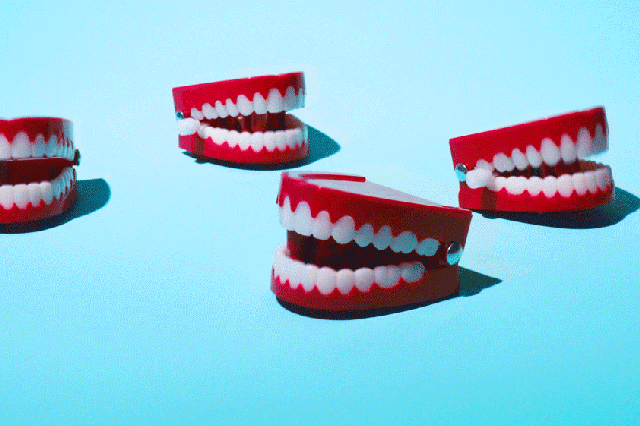- Obtener enlace
- X
- Correo electrónico
- Otras aplicaciones
Matt Martin
You can start by flossing.
At a recent dentist appointment, I smiled confidently for my doctor, Jeffrey Rappaport, DDS (and entrepreneurial badass behind Afora Dental Care). I take pride in my pearly whites, brushing them two or three times daily, flossing nightly, yadda yadda. Rappaport has seen a lot of smiles, but I was sure he’d be impressed.
Wrong.
“Your gums could be healthier,” he tells me after the routine flossing. Apparently I don’t floss firmly enough, as evidenced by the blood I had to spit into that cute little sink beside my chair. “The real way to have healthy teeth is to ensure you have healthy gums,” doc continued. “It’s where the teeth are lodged, after all. Unhealthy gums can lead to tooth loss.”
I’m thinking “D’what?!” like the kid who crammed all weekend for the final exam and somehow still only got a B. Rappaport reassured me, though, that I’m well on my way to a perfect oral grade. I’m no candidate for tooth loss, but I needed to brush up on my gum care. I left wondering how I could do better next time, but also more curious about the gums in general. I hadn’t heard any dentist emphasize them as much before, aside from general flossing rules, so I reached out to Dr. Rappaport with a few questions.
1. Why is gum health just as important (if not more important) than tooth health?
“Our gums are the foundation to healthy teeth and a beautiful smile. When gum tissue becomes infected with bacteria from dental plaque and tartar, bone loss and tooth loss occur. This advanced gingivitis is called periodontal disease. Periodontal disease also puts patients at a higher risk for other medical conditions such as heart disease, dementia, and diabetes. And in [pregnant] women, it can also lead to premature birth.”
2. What are the signs of unhealthy gums? How do we know if they need more attention?
“Do your gums bleed when you brush your teeth? Inflamed and bleeding gums are early symptoms of gingivitis and periodontitis. Healthy gums are firm and pink.”
3. What am I doing wrong?
“Smoking and tobacco use are the big offenders. These patients are at a higher risk for gum disease. Also, poor nutrition and stress will compromise gums. These habits are putting you at a higher risk for gum disease. Plaque (that sticky stuff on your teeth) begins to form soon after brushing, and if it isn't removed, it begins to calcify and spread below the gum line. The bacteria from plaque and tartar causes the gums to swell and bleed as our immune systems kick in to try and fight it.
"Also, don't skip flossing because it ‘wakes you up’ before bed, or only brush for a few seconds when you’re rushing out the door. And ignore the anti-flossing rumors."
ADVERTISEMENT
4. What are the best ways to maintain healthy gums?
“Good oral hygiene is your first and best defense against gum disease. Brushing twice a day, routine flossing, and adding a rinse helps keep plaque and bacteria from sticking around. Flossing below the gum line is important to remove food debris and plaque where our toothbrushes can't reach.”
(This was my offense—not flossing low enough. That's why my gums were sensitive and bled easily.)
“Make sure you are keeping up with regular visits to your hygienist and dentist, too. Most people should go every six months. Patients with crowded teeth or hard-to-reach areas, active orthodontic patients, smokers, and tobacco users are at higher risk for gum disease and may need to have their teeth cleaned every three months.”
5. Noted. You haven’t mentioned gingivitis, but it’s the disease we all hear about in oral-care advertisements. What exactly is it?
“Gingivitis is the precursor to periodontitis. Red, inflamed, and bloody gums are indicators, but the good news is that gingivitis is reversible. When gingivitis is left untreated, it progresses to the more aggressive periodontitis, which has irreversible effects on gum tissue, ligaments, and bone.”
6. Are any foods particularly bad for the gums? Or any that are good?
“There aren't necessarily good or bad foods for the gums. We all know different foods that affect our enamel health: sugars from soda, candy, and carbohydrates, acid from coffee and citrus, and sticky or hard foods. When it comes to healthy teeth and gums, it all boils down to two things: proper, thorough oral hygiene and regular visits to the dentist.”
7. Often, when I go to the dentist, I get X-rays taken of my teeth. Do these also help you identify any risks to my gum health?
“Absolutely. We recommend having X-rays taken anywhere between 12-24 months for healthy patients. Not only do films help check for cavities between teeth, but they can also spot tartar below the gum line, check bone levels, and scan for early stages of periodontal disease called ‘pockets’.”
- Obtener enlace
- X
- Correo electrónico
- Otras aplicaciones


Comentarios
Publicar un comentario